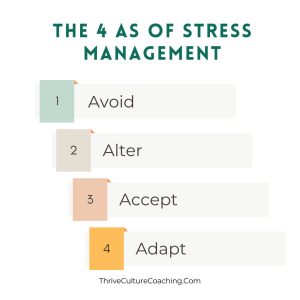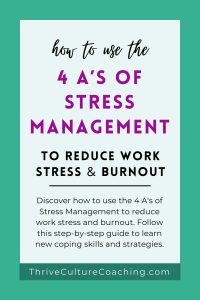Table of Contents
- What Are the 4 A’s of Stress Management?
- Strategies to Change the Situation for Better Stress Management
- Strategies for Managing Stress by Changing Your Response
- Step-By-Step Guide for Using the 4 A’s (with Examples)
- What are the Benefits of the 4 A model of Stress Management?
- Take Action to Reduce Work Stress
 Photo by Aarón Blanco Tejedor on Unsplash
Photo by Aarón Blanco Tejedor on Unsplash
Do you ever feel so overwhelmed by a stressful situation that you can’t seem to think of a way forward? When stress hits, it’s common for creative and strategic thinking to fly out the window. You’re not imagining it—when our brains experience stress, they deprioritize logical thinking and go into survival mode. Thankfully, the 4 A’s of Stress Management can serve as a simple cheat sheet to help you navigate work stress or challenges at home.
What Are the 4 A’s of Stress Management?
The 4 A’s of Stress Management include avoid, alter, accept, and adapt—four strategies to manage stress by either changing the external situation or adjust our internal response to it. This dual approach is one reason I love this tool. It reminds us that even if some stressors are out of our control, we always have options for how we respond and manage our reactions.
Let’s break down these stress management strategies further. The 4 A’s are divided into two categories: actions we can take to modify the situation and adjustments we can make to our own mindset.

The 4 A’s of Stress Management
Strategies to Change the Situation for Better Stress Management
Avoid
The most effective way to manage stress is to eliminate the stressor entirely. It sounds simple, right? Yet, we often skip over this step, focusing instead on better coping strategies—boosting productivity, grit, or resilience. This is my biggest critique of most company-sponsored stress management programs—they focus on improving how employees cope without addressing the root cause of the stress.
Before you skip ahead, ask yourself: Can you remove this stressor completely? Or at least reduce its impact by avoiding it?
Use the “Avoid” tactic to manage stress at work or home:
- Avoid difficult people: If a coworker is consistently causing you stress, can you minimize interactions by sitting farther away, keeping your door closed, or requesting to be put on different projects? At home, practice setting healthy boundaries with individuals who drain your emotional energy.
- Ask to be removed from stressful projects: If a particular project or client is the main cause of your stress, it might be worth talking to your boss to explore being reassigned.
- Change your schedule to avoid stressful situations: If the stress is linked to a specific time or place, consider adjusting your schedule to sidestep the issue.
- Say ‘no’ when possible: Overcommitting often leads to unnecessary stress. Use the mantra, “If it’s not a hell yes, it’s a hell no,” to guide your decisions.
- Delegate or outsource tasks: Delegate tasks at work when possible or hire support at home, such as caregivers or house cleaners, to lighten your load.
- Run a ‘reverse prototype’: Author Greg McKeown suggests trying to stop or reduce tasks that seem to offer little value. If no one notices, it might be a sign the task wasn’t worth the stress.
Alter
If you can’t avoid the stressor, you may be able to alter it. This involves taking steps to change parts of the situation within your control. Ask yourself, “What can I change about this situation?” or, “If I had a magic wand, how would I alter it?”
Examples of how to “Alter” a stressful situation:
-
- Clearly state your expectations: If your stress stems from unmet expectations, make sure you’ve clearly communicated them to others. Miscommunication is a common source of frustration.
- Negotiate for what you need: Whether at work or at home, don’t be afraid to ask for changes that could alleviate stress, like a flexible schedule or additional support.
- Try managing up: If your boss isn’t naturally supportive or responsive, try using I Feel Statements to manage up and get your needs met.
- Ask for help: Enlist others to share the load when possible. Don’t hesitate to ask for assistance when you’re feeling overwhelmed.
- Ask someone to change their behavior: If someone’s actions are contributing to your stress, it’s worth having a conversation about how their behavior impacts you.
- Reduce the scope of your work: Aim for the minimum viable solution when you can. You don’t have to overextend yourself every time.
Strategies for Managing Stress by Changing Your Response
Accept & Adjust
If avoidance or alteration isn’t possible, the next step in the 4 A’s of Stress Management is acceptance. This doesn’t mean giving up but rather acknowledging the limits of your control and focusing on what you can influence—your mindset, emotions, and reactions. Dealing with stress in this way can save you energy and help you adapt more effectively.
How to use the “Accept” tactic:
-
- Acknowledge the struggle & practice self-compassion: It’s okay to feel stressed. Be kind to yourself and remember that you’re doing your best. Tara Brach’s RAIN of self-compassion exercise is extremely helpful.
- Remember, it’s not about you: Often, workplace stress comes from systemic issues, not personal failings. Understanding this can reduce the pressure you put on yourself.
- Practice empathy & forgiveness: If a coworker’s behavior is causing you stress, consider their perspective and practice forgiveness. It can ease tension and create a healthier work environment.
- Embrace non-attachment: Things won’t always go as planned. Let go of the need to control every detail and focus on progress rather than perfection.
- Know when it’s time to move on to a new job: If the stressor is unmanageable and won’t change, it may be time to consider a new job or career path.
- Create healthy work/life boundaries: Proactively protect your personal life from the slow creep of work stress by creating and enforcing healthy work/life boundaries.
Adapt
Finally, when you can’t avoid, alter, or accept the stressor, the 4 A’s of Stress Management tell us that it’s time to adapt. This involves developing resilience and using new coping strategies to better manage the stress.
Ways to adapt to stress:
- Adopt new coping strategies: Try new techniques such as mindfulness, time management, or stress-relief exercises like deep breathing.
- Revise your definition of success: If unrealistic expectations stress you, redefine what success looks like in your job. Aim for balance over perfection.
- Change your standards: Set more realistic goals. For example, instead of aiming to clear your inbox daily, commit to a manageable number of emails.
- Practice positive reframing: Find the silver lining in stressful situations. Could the challenge be an opportunity for growth or learning?
- Rewire your automatic thought patterns: Cognitive behavioral techniques can help you train your brain to respond more calmly and rationally to stress triggers.
- Focus on the positive: Take time to identify and appreciate the parts of your job you enjoy, which can help the stressful aspects feel less overwhelming.
Step-By-Step Guide for Using the 4 A’s (with Examples)
To put the 4 A’s of Stress Management into practice, start by identifying a specific stressor in your life. Let’s say frequent work travel is causing you stress because it disrupts your work-life balance.
Now, cycle through each of the 4 A’s by asking yourself the following questions:
- Avoid: Can I reduce my travel by negotiating a new role or delegating trips to colleagues?
- Alter: Can I change how I approach travel, such as bringing family along or improving logistics to make the experience smoother?
- Accept: Can I accept travel as a part of my role and find ways to enjoy it more, like sticking to a healthier routine while on the road?
- Adapt: Can I build coping mechanisms into my travel routine, such as scheduling daily check-ins with family or setting boundaries to avoid work overload?
What are the Benefits of the 4 A model of Stress Management?
The beauty of the 4 A’s model is that it provides us four options to handle stress in any situation, whether it’s by changing our external environment (by altering or avoiding aspects) or by adjusting our internal response (through acceptance or adaptation).
Practical tools that help us reduce stress is critical, because unchecked chronic stress can easily spiral into burnout and have long term impacts on our health and happiness.
Let’s break down how this approach can seriously improve your work and life.
1. Increased Control Over Stress
When stress hits, it can feel like you’re completely at the mercy of the situation. But with the 4 A’s model, you’re not just sitting back and waiting for the storm to pass. You’re taking the wheel. Whether it’s through avoiding unnecessary stressors or altering your response, this model empowers you to actively manage your stress instead of letting it control you.
2. More Effective Decision Making
By focusing on acceptance and action, you’re training yourself to make decisions that are grounded in clarity, not panic. When you know what’s worth your energy and what’s not, you can focus on the right tasks, say no when necessary, and handle your responsibilities with a clear mind. That’s a recipe for productivity and sanity.
3. Less Burnout
Burnout doesn’t happen overnight; it’s a slow build-up of unmanaged stress. The 4 A’s provide you with a toolkit to balance your workload and emotional energy, so you’re not constantly running on empty. Over time, it reduces the chances of you getting overwhelmed and running out of steam. And who doesn’t want to avoid burnout?
4. Better Emotional Regulation
Stress isn’t just about external demands; it’s about how we react internally. By using the 4 A’s, you’re training yourself to respond to challenges with intentionality rather than reacting out of frustration. This model helps you stay emotionally grounded, whether you’re dealing with a difficult work situation or managing the needs of your personal life.
5. Improved Relationships
Stress management is a game-changer for your relationships, whether with colleagues, clients, or loved ones. When you’re less stressed, you’re more present and more patient with others. Instead of snapping or withdrawing, you’ll find yourself responding with empathy and understanding. The result? Stronger, more meaningful connections.
Take Action to Reduce Work Stress
Stress is inevitable, but it doesn’t have to control your life. The 4 A’s of Stress Management—avoid, alter, accept, and adapt—give you a clear roadmap for managing stress at work and at home. But sometimes, dealing with stress alone can feel overwhelming. If you’re ready to create a more fulfilling, balanced career and reduce burnout, coaching can help.
As a burnout and career coach, I specialize in guiding professionals through personalized strategies to help them thrive. If you’re ready to explore how coaching can support your stress management journey, I invite you to book a free discovery call today. Together, we’ll create a plan that fits your unique needs and goals.
Take the first step toward a healthier, more balanced career by scheduling your free call now.
Pin this post to save these tips for later…





Share